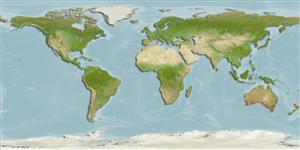Environment: milieu / climate zone / depth range / distribution range
Ecologia
marinhas; estuarina; intervalo de profundidade 0 - 20 m (Ref. 6390). Temperate; 27°S - 44°S
Eastern Indian Ocean: Endemic to Australian temperate waters (Murchison River, Kalbarri in Western Australia to Eden, New South Wales, including Tasmania).
Length at first maturity / Tamanho / Peso / Idade
Maturity: Lm ?, range 25 - ? cm
Max length : 52.0 cm SL macho/indeterminado; (Ref. 10988); peso máx. Publicado: 600.00 g (Ref. 6390); Idade máx. registada: 10 anos (Ref. 27011)
Espinhos dorsais (total): 0; Raios dorsais moles (total): 15-18; Espinhos anais 0; Raios anais moles: 17 - 20; Vértebras: 55 - 61. Gill rakers usually 33 or less on the first arch and usually 26 or less on the second arch. Relatively shorter upper and lower jaw, especially at larger sizes.
Found inshore in surface waters of estuaries, bays, inlets and gulfs to a depth of about 20 m (Ref. 9563). In the South Australian gulfs, southern sea garfish may be found in deeper waters during the colder months (Ref. 27008). Generally herbivorous, seagrasses and algal filaments comprise about 75% of their food (Refs. 26551, 27013). Form schools, generally found near the surface at night and close to the bottom over seagrass beds during the day (Ref. 6390). Post-larvae or young fish less than 1-year-old live in estuaries from March to July then move to inshore marine waters, remaining there for up to 2 years (Ref. 27012).
Collette, B.B., 1974. The garfishes (Hemiramphidae) of Australia and New Zealand. Records of the Australian Museum 29(2):11-105. (Ref. 10988)
Categoria na Lista Vermelha da IUCN (Ref. 130435)
Ameaça para o homem
Harmless
Utilização humana
Pescarias: espécies comerciais; isco: usually
Mais informação
ReferênciasAquaculturaPerfil para aquaculturaEstirpesGenéticaElectrophoresesHereditariedadeDoençasProcessamentoNutrientsMass conversion
ColaboradoresFotografiasStamps, Coins Misc.SonsCiguateraVelocidadeTipo de nataçãoÁrea branquialOutras referênciasCérebrosVisão
Ferramentas
Relatórios especiais
Descarregue XML
Fontes da internet
Estimates based on models
Preferred temperature (Ref.
123201): 14.3 - 22.3, mean 17.6 °C (based on 324 cells).
Phylogenetic diversity index (Ref.
82804): PD
50 = 0.5000 [Uniqueness, from 0.5 = low to 2.0 = high].
Bayesian length-weight: a=0.00257 (0.00115 - 0.00574), b=3.09 (2.91 - 3.27), in cm total length, based on LWR estimates for this Genus-body shape (Ref.
93245).
Nível Trófico (Ref.
69278): 2.7 ±0.27 se; based on food items.
Resiliência (Ref.
120179): Médio, tempo mínimo de duplicação da população 1,4 - 4,4 anos (K=0.51-0.77; tm=2-3; tmax=10).
Fishing Vulnerability (Ref.
59153): Low to moderate vulnerability (28 of 100).
